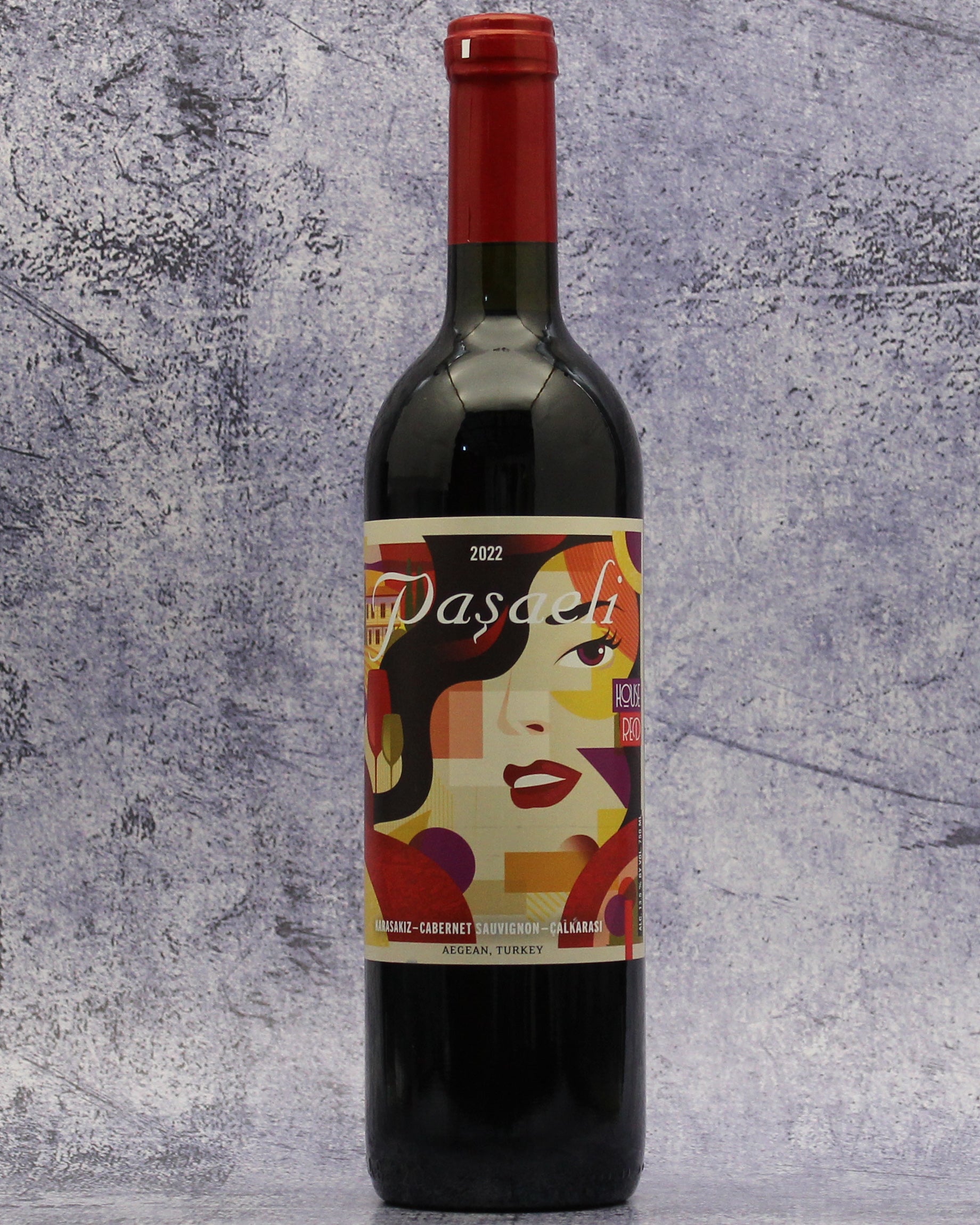Description
From: Aegean, Turkey
Blend: Karasakız (60%), Cabernet Sauvignon (30%), and Çalkarası (10%)
Taste: A captivating bouquet of ripe black cherry and raspberry greet the senses, infused with the subtle nuances of exotic spices and dried herbs. On the palate, the Karasakız lends softness and a delightful, Beaujolais-esque vibe to the wine while the Cabernet Sauvignon imparts structure and an undercurrent of cassis. The Çalkarası adds a final touch, contributing a hint of juicy acidity and a whisper of peach and rose aromas. This light to medium-bodied blend strikes an excellent balance between fruit, acidity, and tannin, resulting in an approachable yet intriguing wine (chill down a touch, especially during the summer months).
Pairing: Given the fresh, fruit-forward character of the 2022 Pasaeli House Red, it would pair well with a variety of dishes that highlight similar flavor profiles. A classic Turkish kebab, featuring marinated grilled beef skewers, would harmonize beautifully with the wine's fruitiness and underlying spice tones (J. Kenji López-Alt has a recipe for a vegan version with sumac onions and a garlic-dill mayonnaise). The wine's medium body and soft tannins would complement the protein without overwhelming it. Other dishes that would be wonderful alongside this wine include lamb and eggplant pide, spiced lamb meatballs with yogurt and herbs, smoky eggplant salads with yogurt and mint, spinach and feta boreks and lamb boreks (check out David Tanis’ recipe below).
Turkish-Style Lamb Boreks
By David Tanis
About. Turkey, an ancient wine country bridging Eastern Europe and Western Asia, has an illustrious and deeply rooted history in viticulture. The country's wine narrative goes as far back as Noah's time when, as local legend has it, he planted the first vines on the slopes of Mount Ararat. This historic legacy has given Turkey a vast gene pool of grapes, boasting over 600 indigenous varieties. Today, we explore an intriguing wine that embodies Turkey's rich viticulture: the 2021 Pasaeli House Red from the Aegean region.
Crafted by the family-owned Pasaeli wine estate, the 2021 House Red marries three grape varieties: Karasakız (60%), Cabernet Sauvignon (30%), and Çalkarası (10%). This selection captures the multifaceted terroir of the Aegean region, expressing all its rich diversity. Each grape variety hails from a unique terroir and is fermented using native yeast, creating an elegant blend that speaks of the region's distinct character. This blend is a fresh, fruit-forward delight that would not be out of place in the bustling bistros of Istanbul and beyond.
The Pasaeli estate was founded in 2000 by Seyit Karagözoğlu, a native of İzmir who nurtured a deep appreciation for agriculture and a passion for wine from an early age. Having spent a decade as a wine importer, Seyit recognized Turkey's ideal conditions for grape growing. This led him to establish Pasaeli, planting indigenous varieties like Sultaniye, Yapıncak, Çalkarası, and Karasakız in the Aegean region, along with Bordeaux varieties near İzmir. These wines are not only well-balanced and expertly crafted but also offer great value.
Two key figures in the wine world, Michael and Harmon Skurnik, met Seyit at an event at Vinitaly. They became so enthralled with his lineup of Turkish wines that they couldn't resist adding them to their portfolio. The majority of Pasaeli wines are crafted from indigenous Turkish varieties, with the addition of a Bordeaux blend. These wines have eye-catching labels, detailed descriptions, and are fairly priced, offering excellent value for wine enthusiasts.
Let's delve deeper into the indigenous grape varieties featured in the 2021 House Red blend: Karasakız and Çalkarası.
Karasakiz, also known as "Kuntra", is a native Turkish grape variety occasionally found in Greece. It is known for producing light-bodied, soft red wines that offer a symphony of candied berry fruit flavors. While Karasakız's place in Turkish wine culture has been largely overtaken by more robust French varieties like Merlot, Cabernet Sauvignon, and Syrah, it still shines in blends like the Pasaeli House Red. Some recommended food pairings for Karasakız wines include roasted eggplant with haloumi, marinated grilled-beef skewers, and pasta with tomatoes and black olives.
Çalkarası, on the other hand, is an obscure grape variety that originates from the Çal district of Denizli, located in the southwestern Aegean region of Turkey. It typically produces juicy, moderately acidic rosé wines with aromas of peach and rose and straightforward flavors of strawberry and raspberry. Although it is commonly used to make rosé, Çal Karasi also contributes to light red wines and is sometimes found in a sparkling rosé variant. A Turkish-inspired raspberry roll cake or a simple paprika fish stew would make a perfect pair with a Çal Karasi rosé.
The Pasaeli House Red comes from the Aegean Coast, a region that claims more than half of Turkey's wine production. The coastal area enjoys a moderate Mediterranean climate, but the higher altitudes inland offer a more continental ambiance. The region grows an array of native varieties along with international grapes like Cabernet Sauvignon, Syrah, and Merlot.
While Turkey's wine production is currently dwarfed by other major wine countries, there is growing interest in its indigenous wines. A new generation of boutique wineries, like Pasaeli, are beginning to make their mark in the industry. As Lillian Lai, vice president of House of Burgundy, points out, "wine enthusiasts are eager to discover new indigenous grapes." The story of Turkish wine is still unfolding, and wines like the 2021 Pasaeli House Red continue to unveil the unique characters and bold personalities of Turkish wines to the world.

